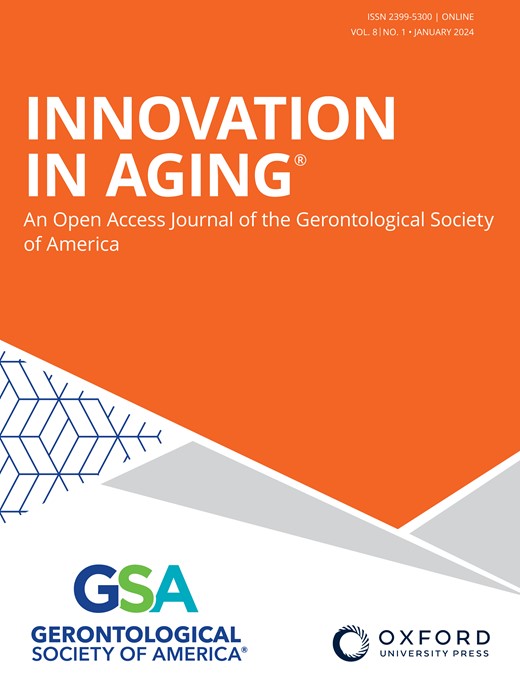DIVERSE ENVIRONMENTAL CONTEXTS AND LINKS TO LATER-LIFE WELL-BEING
IF 4.9
3区 医学
Q1 GERIATRICS & GERONTOLOGY
引用次数: 0
Abstract
Abstract The places older adults spend time have profound impacts on their well-being. As new sources of data and methods become available it is imperative to refine work in this area to guide development of interventions with the precision necessary to address persistent disparities in well-being. This symposium brings together four complementary papers that focus on diverse environmental contexts and well-being using multiple methodological approaches. Perzynski, Berg, and Dalton discuss the potential of Digital Twin Neighborhoods, i.e., digital replicas of real communities, to address health inequalities. They present findings from engagement sessions with community members about priorities, preferences, and concerns with regard to use of digital twins. Sol, Clarke and Zahodne link data from the Detroit-area Michigan Cognitive Aging Project with data from the National Neighborhood Data Archive to examine the association between neighborhood disadvantage and cognitive reserve. They show how this association differs between Black and White participants. Cho, Dunkle, and Smith use data from the Health and Retirement Study (HRS) to examine the association between later life relocation and contact frequency with adult children. They illustrate the importance of proximity and mode of contact in this association. Morris and colleagues also use HRS data to examine the extent to which stressors operating at multiple levels (interpersonal, community, and society) explain racial disparities in memory. They show these contexts together explain 11% of the racial disparity in baseline memory. These papers will be discussed by Markus Schafer who will provide an outlook for future research in this area.不同的环境背景以及与晚年生活的联系
摘要 老年人的活动场所对他们的福祉有着深远的影响。随着新数据源和新方法的出现,完善这一领域的工作势在必行,以便以必要的精确性指导干预措施的开发,解决福祉方面持续存在的差异。本次研讨会汇集了四篇互补性论文,这些论文采用多种方法关注不同的环境背景和幸福感。Perzynski、Berg 和 Dalton 讨论了数字孪生社区(即真实社区的数字复制品)在解决健康不平等问题方面的潜力。他们介绍了与社区成员就使用数字孪生社区的优先事项、偏好和关注点进行交流的结果。Sol、Clarke 和 Zahodne 将底特律地区密歇根认知老化项目的数据与国家邻里数据档案的数据联系起来,研究邻里劣势与认知储备之间的关联。他们展示了黑人和白人参与者之间的关联差异。Cho、Dunkle 和 Smith 利用健康与退休研究 (HRS) 的数据研究了晚年搬迁与成年子女接触频率之间的关系。他们说明了近距离接触和接触方式在这种关联中的重要性。莫里斯及其同事还利用 HRS 数据研究了多层次(人际、社区和社会)的压力因素在多大程度上解释了记忆中的种族差异。他们的研究表明,这些因素加在一起可以解释基线记忆中 11% 的种族差异。Markus Schafer 将对这些论文进行讨论,并对这一领域的未来研究进行展望。
本文章由计算机程序翻译,如有差异,请以英文原文为准。
求助全文
约1分钟内获得全文
求助全文
来源期刊

Innovation in Aging
GERIATRICS & GERONTOLOGY-
CiteScore
4.10
自引率
0.00%
发文量
72
审稿时长
15 weeks
期刊介绍:
Innovation in Aging, an interdisciplinary Open Access journal of the Gerontological Society of America (GSA), is dedicated to publishing innovative, conceptually robust, and methodologically rigorous research focused on aging and the life course. The journal aims to present studies with the potential to significantly enhance the health, functionality, and overall well-being of older adults by translating scientific insights into practical applications. Research published in the journal spans a variety of settings, including community, clinical, and laboratory contexts, with a clear emphasis on issues that are directly pertinent to aging and the dynamics of life over time. The content of the journal mirrors the diverse research interests of GSA members and encompasses a range of study types. These include the validation of new conceptual or theoretical models, assessments of factors impacting the health and well-being of older adults, evaluations of interventions and policies, the implementation of groundbreaking research methodologies, interdisciplinary research that adapts concepts and methods from other fields to aging studies, and the use of modeling and simulations to understand factors and processes influencing aging outcomes. The journal welcomes contributions from scholars across various disciplines, such as technology, engineering, architecture, economics, business, law, political science, public policy, education, public health, social and psychological sciences, biomedical and health sciences, and the humanities and arts, reflecting a holistic approach to advancing knowledge in gerontology.
 求助内容:
求助内容: 应助结果提醒方式:
应助结果提醒方式:


